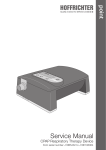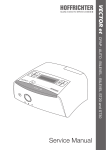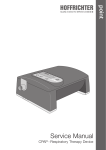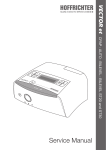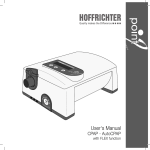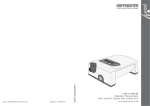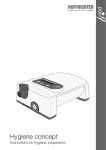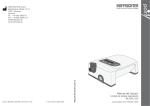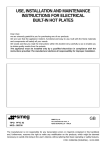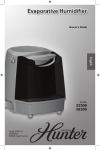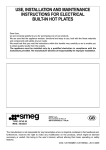Download Service manual - Hoffrichter GmbH
Transcript
Service manual Respiratory therapy device point 2 Contents 1 Symbols in this manual....................................................................................................3 2 General.............................................................................................................................3 3 Safety information............................................................................................................3 4 4.1 4.2 4.3 Device description............................................................................................................4 Housing, display and control elements...............................................................................4 Exploded view drawing......................................................................................................5 Controller circuit board......................................................................................................6 5 Technical explanations.....................................................................................................8 6 6.1 6.2 6.3 6.4 6.5 6.6 6.7 6.8 6.9 6.10 6.11 6.12 6.13 Tools and measuring equipment....................................................................................10 Preliminary Steps.............................................................................................................10 ADU-Test.........................................................................................................................11 Checking display and contrast.........................................................................................12 Opening the device..........................................................................................................12 Cleaning..........................................................................................................................12 Checking the heating cable..............................................................................................12 Assembling the device.....................................................................................................13 Checking the keys...........................................................................................................13 Excess pressure calibration.............................................................................................13 Sensor test......................................................................................................................14 Resetting counters, setting date and time........................................................................14 Restoring device settings.................................................................................................14 Checking electrical safety................................................................................................14 7 7.1 7.2 Resetting the therapy hour counter and de-/activating the PIN code function directly at the device...................................................................................................................15 Resetting the therapy hour counter..................................................................................15 De-/activating the PIN code function................................................................................15 8 Final steps......................................................................................................................15 9 9.1 9.2 9.3 9.4 Disposal.........................................................................................................................16 Device and components..................................................................................................16 Packaging.......................................................................................................................16 Batteries..........................................................................................................................16 Accessories and wear parts.............................................................................................16 Other tests (not part of device servicing).....................................................................................17 Pressure stability measurement.....................................................................................................17 -2- 1 Symbols in this manual Important information is denoted by symbols in this service manual. Be sure to follow these instructions in order to avoid accidents, personal injury and material damage. In addition, the local accident prevention regulations and general safety regulations in force in the area of use must be observed. This symbol denotes general safety instructions. Follow these instructions to avoid accidents, personal injury or material damage. This symbol denotes hazardous situations that may lead to moderately severe injuries. This symbol denotes situations that may lead to material damage or damage to the device. This symbol denotes information, tips and instructions for efficient, error-free use of the device. 2 General •• Before starting maintenance, read this service manual through carefully. Observe the user’s manual as well as the warning and safety instructions it contains. •• Repair and maintenance may only be carried out by qualified, authorized and competent specialist personnel. •• This manual refers solely to the point 2 respiratory therapy device. It does not deal with accessories such as therapy tubes and masks. If an accessory is suspected of being defective, it should be visually inspected by the service technician and the result recorded in the servicing report. 3 Safety information •• For hygiene reasons, we recommend wearing disposable gloves whenever working on the device. Before further work, the device must be subjected to wipe disinfection with a standard disinfectant solution. When doing so, observe the manufacturer‘s safety instructions and instructions for use. •• The documents delivered with the device must be checked when the device arrives at the Service department. Devices contaminated with MRSA (methicillinresistant Staphylococcus aureus) must be subjected to hygienic preparation according to the validated KR1000 (Keredusy) preparation procedure. All other devices must be prepared according to the point 2 hygiene concept. •• Special hygiene measures are advisable when performing maintenance or repairs on devices contaminated with MRSA. In this case, protective clothing such as disposable gloves, mask and disposable apron should be worn without fail. Hygienic preparation according to the validated KR1000 (Keredusy) preparation procedure must be carried out before performing maintenance or repair. -3- 4 Device description 4.1 Housing, display and control elements Control panel and display Humidifier lock Therapy tube connection Contact socket for humidifier1 Controls for humidifier1 Fig. 1: Front view of the device Air inlet for barometric sensor 24 V DC connection JAB122020 RS232 interface Rating plate Filter or connection port for the filtersystempoint 2 Fig. 2: Rear view of the device Window element for display underneath 1 Selector keys Enter key Fig. 3: Control panel 1 optional equipment variant for use with humidifier -4- ON / OFF key 4.2 Exploded view drawing Membrane keyboard Top section of housing Display Controller circuit board Microphone cover Meander lid Acoustic hood Blower bellows Fixing element Retaining ring Blower Fixing element Fixing element Flow resistance Damper Damper Sealing gasket (internal) - air outlet Damper Room divider Acoustic protection plate Cover plate for DC and PC connection Air outlet PC connection cover Bottom section of housing Base (rear) Filter insert Control panel base Adapter for humidifier Base (front) Housing foot Cover for humidifier electronics guide -5- Housing foot 4.3 Controller circuit board 4.3.1solder side Battery contact Battery contact Alarm generator Plug connection for humidifier electronics Plug connection for Display membrane keyboard Fig. 4: Controller board (solder side) -6- 4.3.2Component side Serial interface 24 V DC input Microphone Motor control connection P246 P257 Motor voltage connection Battery contact Battery contact Pressure sensor Backup battery for internal clock CPU (ATMEGA 2561) PK (display contrast) Fig. 5: Controller (component side) The settings on the potentiometers P246 and P257 must not be changed, as this would necessitate recalibration at the factory. -7- 5 Technical explanations Patient, Respiratory mask Humdifier (optional) point device Blower box Pressure Sensor Load management Blower PI controller Motor D/A converter Motor controller CPU Display Flash RAM EEPROM ADC external EEPROM Control panel DC power supply unit RS232 RCI AC mains Battery Fig. 6: Block diagram Heating (when optional humidifier is connected) The humidifier heating consists of a heating element in the bottom of the humidifier. The heating power can be set to 5 different heating levels using the controls. The maximum temperature of the heating plate is limited to 60 °C. In addition, there is a thermal fuse in the electronic unit of the humidifier, which trips at a temperature of 90 °C in the event of a fault. Power supply The device is operated via an external switched-mode power supply with a wide input range of 100 - 240 V AC and a frequency of 50 - 60 Hz. No maintenance or repairs should be performed on the switched-mode power supply. -8- Motor control A piezoelectric sensor (differential pressure measuring procedure, measuring range: 0 ... 3500 Pa) continuously measures the actual output pressure. The set-point pressure value is output by the computer. The difference between these two values is corrected by the PI controller and the motor control. Switching controllers are used to minimize power losses. Motor DC motor, operating voltage 4 - 24 V, electronically commutated point 2 processor (ATmega2561) The ATmega 2561 processor is a microcontroller which is used in all point 2 devices. The key technical data includes: •• 256kByte flash memory •• 4kByte EEPROM •• 8kByte RAM •• programmable interface •• an integrated A/D converter (10 bit) •• 54 programmable I/O pins Clock The point has a real-time clock. The real-time clock is supplied by an internal battery (CR2032), which offers an operating time of 8 to 10 years. This battery supplies the IC with power when the device is disconnected from the mains. With mains operation the clock is supplied with power by the power supply unit. Alarm generator Output of an acoustic alarm for wake-up function as well as in the case of absent or excessive mask pressure. -9- 6 Tools and measuring equipment 6.1 Preliminary Steps 6.1.1Protective Agents and Disinfectants •• Hand sanitizers: e.g. Sterillium® (Bode) •• Disinfectant sprays: e.g. Mikrozid® AF Liquid •• Surface disinfectants: e.g. Mikrozid® AF •• In the case of medical devices exposed to hazardous contamination (MRSA), additional protective clothing such as disposable gloves, a mask and a disposable apron and goggles should be worn. Where possible, wipe disinfection is preferable to spray disinfection. 6.1.2Tools, measuring equipment and aids The following equipment is required for servicing: •• Service manual, user‘s manual and maintenance documents •• Battery pack (powerpackpoint 2) or point 2 power supply unit with mains cable •• Phillips screwdriver PH0 and PH1 •• Slot screwdriver 06x3,5 •• Soft brush and vacuum cleaner •• Soft base •• point auxiliary tool (art. no. 00007939) •• Therapy tube (1.80 m long with 22 mm therapy tube connection as per ISO 5356-1) •• Flow resistor, 4 mm (art. no. 00007303) •• Flow resistor, 5 mm (art. no. 00007306) •• RS232 adapter cable (Sub-D9 / RJ45 art. no. 00005232) •• Device for testing electrical safety (e.g. SECUTEST SIII/DIN EN 62353:2008) •• PC with following system requirements: –– –– –– –– –– –– –– –– –– –– MS Windows® 98, 2000, NT4.0, ME, XP, Server 2003, Vista or 7 AMD Athlon/Pentium class (x86), clock frequency 700 MHz min. 192 MB system memory for MS Windows® 98, NT4.0, ME min. 400 MB system memory for MS Windows® 2000, XP, Server 2003, Vista min. 150 MB free hard drive space (or more depending on the required storage capacity for patient files) min. 280 MB free hard drive space for the Microsoft .NET Framework 2.0 Redistributable (x86) 2 MB graphics card min. High Color (16 bit) Mouse 1 free COM interface per device 1 free SD interface (only when using DATA box) •• HOFFRICHTER TRENDset PC software •• Cleaning agent for cleaning surfaces, e.g. solution of soapy water in a standard concentration All tools, measuring equipment and aids possibly exposed to contamination must be cleaned after they have been used and treated with disinfectant. - 10 - 6.1.3Unpacking and disinfecting To protect against germs, the surface of the device and, where present, the humidifier must be treated with a disinfectant immediately after unpacking. 6.1.4Checking for external damage Before starting the service, check the device and, where present, the humidifier for external damage. 6.1.5Data backup Before starting the service, perform a data backup. 1. Connect the device to the mains power (using mains cable and power supply unit). 2. Use the PC cable to connect the device to the PC. 3. Start the TRENDset PC software. 4. For security reasons, make sure you save the device settings (File > Save as...). 5. Print out the device settings (File > Print) and keep the printout for data recovery. 6.2 ADU-Test 1. Insert the flow resistor (4 mm) into the air outlet opening. 2. Disable the soft start function and the mask test on the device. 3. Go to “Settings > Service > Log in” in the menu bar. 4. Enter „service“ as the User Name. 5. Enter „user140372“ as the Password. 6. Select the view „Times and Counters“. 7. Click on the button „ADU Test“ to open the „ADU Test“ window. 8. Start measurement by clicking on the button „Start“ in the top right. The entire pressure range is now checked for pressure deviations. The maximum deviation must not exceed ± 0.5 hPa. If the maximum deviation is exceeded, you should perform automatic zero-point calibration of the pressure sensor. To do so, operate the device for min. 2 hours in standby. During this period, the device continuously measures the ambient temperature and determines a correction factor that is used as a basis for the pressure sensor‘s zero-point calibration system. Perform zero-point calibration at the same location as for performance of the ADU Test. This will lead to better results. Then perform the ADU Test once again. If the measured pressure deviation still exceeds the maximum deviation limit, contact the manufacturer. 9. Close the „ADU Test“ window. - 11 - 6.3 Checking display and contrast 1. Press any key. The display lights up with a brightness of 100%. 2. Check the display to see whether all characters are shown correctly and completely. 3. The background of the display is illuminated – the display should be clearly legible in daylight. 4. After 15 seconds the display fades to the basic brightness level selected in the device menu (0 - 100 %). The display should still be clearly legible. 5. If required, the display contrast can be re-adjusted via PK with the device open (see Fig. 5 on page 7). 6.4 Opening the device 1. Unplug the mains plug. 2. Remove the filter or the filter system filtersystempoint 2 (optional). 3. Remove the humidifier, where present. 4. Remove the two batteries (powerpackpoint 2), where present. 5. Place the device top down on the soft base. 6. Open the device as follows: a. Remove the feet of the housing. b. If the point 2 is set up for the connection of a humidifier, remove the control electronics of the humidifier and disconnect the plug connection. c. Release the four screws at the housing. d. Take off the upper casing of the housing. 6. Disconnect the plug connections and the pressure measuring connection. 7. Carefully remove the heating cable (using aids if necessary). Avoid any tension on the microphone tubing. 6.5 Cleaning 1. Clean the inside of the device carefully using the brush and the vacuum cleaner. 2. Use compressed air to clean areas which are not readily accessible. Then remove loose particles with the vacuum cleaner. 3. Remove stubborn dirt inside and outside the upper casing of the housing and in the opened device (not circuit boards) using a damp cloth and a solution of soapy water in a standard concentration. 4. Optional: If a humidifier is present, wash out the water container with water and apply a 5% solution of vinegar to stubborn limescale. 6.6 Checking the heating cable Check that the heating cable is still intact and that the contact springs are not bent. On assembly, the heating cable must be protected from tension, compression and clamping. - 12 - 6.7 Assembling the device Only start assembly once all cleaning agents and disinfectants have dried completely. 1. Position the motor cable in the space between the motor and the wall of the housing and run the heating cable between the box and the wall of the housing. 2. Position the pressure measuring tube above the controller circuit board and connect it to the pressure sensor. 3. Check whether the controller circuit board is properly seated in its correct position. 4. Check all plug connections on the controller circuit board for secure positioning and, where necessary, correct deficiencies. 5. Carefully fit the upper case of the housing, making sure that no cables or tubes are compressed or crushed. 6. Turn the device over and screw the upper and lower casing together. Then reattach the housing feet. 7. If the point 2 was set up for the connection of a humidifier, install the controls and the control electronics of the humidifier. 8. Insert the filter or fit the filtersystempoint 2 (optional). 6.8 Checking the keys 1. Check that the turbine switches on and off properly when the ON/OFF key is pressed. 2. Check whether the menu can be operated properly using the arrow keys. 6.9 Excess pressure calibration Excess pressure calibration is used for test measuring the pressure limiting value. It needs to be performed whenever hardware components were added, replaced or removed. 1. Use the RS232 adapter cable to connect the device to the PC. 2. Connect the therapy tube to the device and plug the 5 mm flow resistor into the tube’s open endpiece. 3. Start the TRENDset PC software and click on the device at “Found devices”. 4. Go to “Settings > Service > Log in” in the menu bar. 5. Enter „service“ as the User Name. 6. Enter „user140372“ as the Password. 7. Select view „Times and Counters“. 8. Click on the „Calibration“ button. 9. Follow the instructions on the PC screen. 10. If calibration fails despite being executed correctly, check the device for loose or incorrectly attached connectors (plugs, tubes, etc.) or any other installation errors. If calibration fails permanently, please contact the HOFFRICHTER service department. - 13 - 6.10 Sensor test The sensor test needs to be performed whenever changes to the controller circuit board were made. 1. Use the RS232 adapter cable to connect the device to the PC. 2. Connect the therapy tube to the device and plug the 5 mm flow resistor into the tube’s patient side endpiece. 3. Start the TRENDset PC software and click on the device at “Found devices”. 4. Go to “Settings > Service > Log in” in the menu bar. 5. Enter „service“ as the User Name. 6. Enter „user140372“ as the Password. 7. Select view „Times and Counters“. 8. Click on the „Sensor test“ button. 9. Follow the instructions on the PC screen. If the microphone- and/or barometer test fails despite the sensor test being executed correctly, check whether all tubes are properly connected and not squeezed or kinked. If the test fails permanently, please contact the HOFFRICHTER service department. 6.11 Resetting counters, setting date and time 1. Use the RS232 adapter cable to connect the device to the PC. 2. Start the TRENDset PC software and open the connected device at „Found devices“. 3. Select the view „Times and Counters“. 4. Reset the filter counter if the filter was changed. 5. Reset the blower runtime if the blower box was changed. 6. Reset the date and time if necessary. 7. Click on „Send“. 6.12 Restoring device settings 1. Select the view „Patient Data“. 2. If necessary, enter the patient data using the data backup (printout). 3. Click on „Send“ to store the settings in the device. 4. Select the view „Device Settings“. 5. If necessary, enter the patient data using the data backup (printout). 6. Click on „Send“ to store the settings in the device. 6.13 Checking electrical safety The point basic device is equipped with protective insulation and does not have any exposed electrically conductive parts at the housing. As such, electrical safety testing of the device is unprovided for. Electrical safety testing is only possible on the power supply unit and is performed by a device safety tester (e.g. SECUTEST SIII), which complies with the DIN EN 62353:2008 standard. The reference point is the ground conductor on the secondary side of the power supply unit (external contact). - 14 - 7 Resetting the therapy hour counter and de-/activating the PIN code function directly at the device 7.1 Resetting the therapy hour counter 1. Keep the selector keys and both pressed down while connecting the power supply to the device’s DC power connection. 2. Therapy Counter Reset Press 3. Press the enter key 4. appears on the display. . Therapy Counter deleted appears on the display. 7.2 De-/activating the PIN code function Deactivating the PIN code function 1. Keep selector key and enter key both pressed down while connecting the power supply to the device’s DC power connection. 2. PIN Code OFF? Press 3. Press the enter key 4. appears on the display. . PIN Code OFF appears on the display. Make sure to reactivate the PIN code function before the device is passed on (e.g. to patients). Activating the PIN code function 1. Keep selector key and enter key both pressed down while connecting the power supply to the device’s DC power connection. 2. PIN Code ON? Press 3. Press the enter key 4. PIN Code ON. appears on the display. . appears on the display. 8 Final steps After finishing servicing, draw up a final report and affix a test seal showing the date and tester‘s initials to a suitable position on the device. - 15 - 9 Disposal Proper disposal saves natural resources and prevents the release of harmful substances into the environment. 9.1 Device and components The device and its electronic components must not be disposed of with household waste. They must be disposed of at a communal collection point or public waste disposal authority. 9.2 Packaging The packaging can be recycled or be disposed of with household waste. 9.3 Batteries Batteries must not be disposed of with household waste. They must be returned to the distributor or disposed of at a communal collection point. 9.4 Accessories and wear parts Disposal of accessories such as tubing, masks, filter cassettes and wear parts (e.g. sealing gaskets) and other replaced components must be carried out according to the statutory provisions in force at the area of use. This also applies to contaminated accessories. - 16 - Other tests (not part of device servicing) Pressure stability measurement To check the device’s pressure stability according to EN ISO 17510-1:2009 clause 6.8.2 aa) appendix BB.2 (14-4 3/2007 MDS Hi), the device has to be put in basic CPAP mode by deactivating oscillation. Deactivating oscillation 1. Keep selector key and enter key both pressed down while connecting the power supply to the device’s DC power connection. 2. Oscillation OFF? 3. Press the enter key 4. Press appears on the display. . Oscillation OFF appears on the display. Make sure to reactivate the oscillation after pressure stability measurement. Otherwise obstructive apneas won’t be detected during therapy. Activating oscillation and enter key both pressed down while connecting the power supply 1. Keep selector key to the device’s DC power connection. 2. Oscillation ON? 3. Press the enter key 4. Press appears on the display. . Oscillation ON appears on the display. HOFFRICHTER GmbH Mettenheimer Straße 12 / 14 19061 Schwerin Germany phone: +49 385 39925 - 0 fax: +49 385 39925 - 25 e-mail: [email protected] web: www.hoffrichter.de point 2-service-eng-060612-03 - 17 -


















